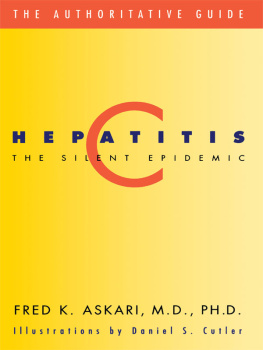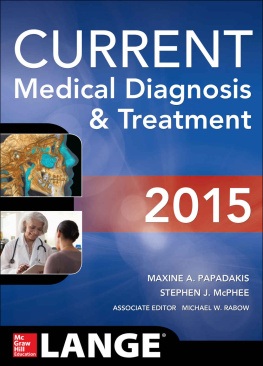Cover

| title | : | Viral Hepatitis : Diagnosis, Treatment, Prevention Gastroenterology and Hepatology (New York, N.Y.) ; 4 |
| author | : | Willson, Richard A. |
| publisher | : | Informa Healthcare |
| isbn10 | asin | : | 0824794168 |
| print isbn13 | : | 9780824794163 |
| ebook isbn13 | : | 9780585377100 |
| language | : | English |
| subject | Hepatitis, Viral, Hepatitis, Viral, Human--diagnosis, Hepatitis, Viral, Human--therapy, Hepatitis Viruses. |
| publication date | : | 1997 |
| lcc | : | RC848.H43V5735 1997eb |
| ddc | : | 616.3/623 |
| subject | : | Hepatitis, Viral, Hepatitis, Viral, Human--diagnosis, Hepatitis, Viral, Human--therapy, Hepatitis Viruses. |
Page null03
Viral Hepatitis
Page null04
Gastroenterology and Hepatology
Executive Editor
J. Thomas LaMont, M.D.
Chief, Division of Gastroenterology
Beth Israel Hospital
Boston, Massachusetts
and
Charlotte F. and Irving W. Rabb Professor of Medicine
Harvard Medical School
Boston, Massachusetts
1. Crohn's Disease , edited by Cosimo Prantera and Burton I. Korelitz
2. Clinical Gastroenterology in the Elderly , edited by Alvin M. Gelb
3. Biliary and Pancreatic Ductal Epithelia: Pathobiology and Pathophysiology , edited by Alphonse E. Sirica and Daniel S. Longnecker
4. Viral Hepatitis: Diagnosis Treatment Prevention , edited by Richard A. Willson
ADDITIONAL VOLUMES IN PREPARATION
Gastrointestinal Infections , edited by J. Thomas LaMont
Page i
Viral Hepatitis
Diagnosis Treatment Prevention
edited by
Richard A. Willson
Harborview Medical Center and
University of Washington
Seattle, Washington

Page ii
ISBN: 0-8247-9416-8
The publisher offers discounts on this book when ordered in bulk quantities. For more information, write to Special Sales/Professional Marketing at the address below.
This book is printed on acid-free paper.
Copyright 1997 by Marcel Dekker, Inc. All Rights Reserved.
Neither this book nor any part may be reproduced or transmitted in any form or by any means, electronic or mechanical, including photocopying, microfilming, and recording, or by any information storage and retrieval system, without permission in writing from the publisher.
MARCEL DEKKER, INC.
270 Madison Avenue, New York, New York 10016
Current printing (last digit):
10 9 8 7 6 5 4 3 2 1
PRINTED IN THE UNITED STATES OF AMERICA
Page iii
Preface
Over the past decade, there has been an explosion of new knowledge about human hepatitis viruses A, B, C, D, and E (Chaps. 27). Although volunteer studies in the 1950s and 1960s extended our understanding of some of these viruses, these studies were always controversial. Fortunately, the development of animal models either involving natural viral infections or transgenically created for the study of viral hepatitis has paralleled the decline in volunteer studies and has advanced our understanding of viral replication and pathogenesis. These aspects are reviewed in Chapter 3. The use of nonhuman primates for studies of transmission of HAV, HBV, HCV, HDV, and HEV has led to better characterization of these viruses, to the development of new serological techniques in some circumstances to the isolation of the virus and to the development of vaccines.
Many of the foregoing advances in our understanding of the hepatitis viruses were accomplished through the utilization of classic virological techniques. Today, however, advances are being made rapidly by applying molecular biological techniques to virology. Indeed, hepatitis virology has become the domain of molecular biologists. Molecular and immunological approaches have been joined to better understand virus and host responses during acute and chronic infection. Such an approach allows the molecular characterization of a virus before it has been visualized by electronmicroscopy or even been isolated in cell culture (for example, the recent cloning of HCV, HEV, and HGV). In addition, current molecular virological techniques allow more rapid characterization of variant mutants of the hepatitis viruses. Although viral mutants have been recognized for some years, their significance has only recently been recognized in changing the virus' poten
Page iv
tial virulence in the clinical context, in changing its mode of pathogenesis, in effecting its response to treatment, and in altering its response to a vaccine.
Progress in clinical understanding of human hepatitis viruses has evolved closely with the development of diagnostic tests for detecting the viral infection and the host's immune response to the infection. Radioimmunoassay (RIA) and enzyme-linked immunosorbent assay (ELISA) have provided sensitive and specific diagnostic measures of acute and chronic infections. The recent development of the polymerase chain reaction (PCR) has made possible the detection of viruses that replicate at such low levels that they cannot be detected by other, more conventional, techniques (e.g., HCV and HEV). These modern serological techniques are summarized in Chapter 1.
The association between HBV and HCV and hepatocellular carcinoma has been recognized, particularly in Asia and Africa. This has fostered investigation into the multiple potential pathways leading from chronic viral hepatitis to hepatocellular carcinoma. This serious long-term consequence of chronic viral hepatitis infection is reviewed in Chapter 10.
Although clinically viral hepatitis presents mainly with hepatic manifestations, on occasion, extrahepatic features predominate and may complicate the diagnosis (Chap. 11). The overlap between chronic viral hepatitis and autoimmune hepatitis is challenging to the clinician and is reviewed in Chapter 12. Viral hepatitis occurs commonly in immunocompromised patients, and can have serious clinical consequences and present additional therapeutic challenges. These special circumstances are discussed in Chapters 14 and 15.
Perhaps the most exciting advances in viral hepatitis have been in therapy, particularly in chronic viral hepatitis B and C (Chaps. 4 and 5). However, only a fraction of patients respond to the current therapy with alpha interferon and therefore better and less expensive therapies need to be developed. Continuing advances in knowledge about chronic viral hepatitis promise to bring future improvements in therapy of these diseases.
Clearly, the prevention of viral hepatitis is a major goal, and considerable progress has been made in the development of vaccines against the hepatitis viruses. Universal HVB vaccination is currently underway (Chap. 4) and the HVA vaccine (Chap. 2) has recently been licensed in the United States (as it had been previously in Europe). Prospects for an HEV vaccine appear bright; however, the development of an HCV vaccine appears less certain. Vaccination against viral hepatitis is the most cost-effective medical strategy, because therapy of both its sequelae end-stage liver disease (cirrhosis) and hepatocellular carcinoma is very expensive and complex (Chaps. 10 and 13).
Next page









